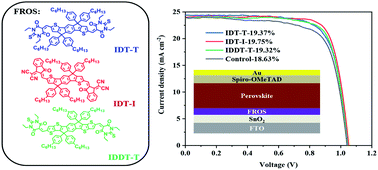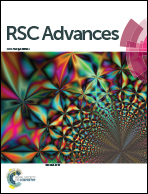The roles of fused-ring organic semiconductor treatment on SnO2 in enhancing perovskite solar cell performance†
Abstract
It took only 11 years for the power conversion efficiency (PCE) of perovskite solar cells (PSCs) to increase from 3.8% to 25.2%. It is worth noting that, as a new thin-film solar cell technique, defect passivation at the interface is crucial for the PSCs. Decorating and passivating the interface between the perovskite and electron transport layer (ETL) is an effective way to suppress the recombination of carriers at the interface and improve the PCE of the device. In this work, several acceptor–donor–acceptor (A–D–A) type fused-ring organic semiconductors (FROS) with indacenodithiophene (IDT) or indacenodithienothiophene (IDDT) as the bridging donor moiety and 1,3-diethyl-2-thiobarbituric or 1,1-dicyromethylene-3-indanone as the strong electron-withdrawing units, were deposited on the SnO2 ETL to prepare efficient planar junction PSCs. The PCEs of the PSCs increased from 18.63% for the control device to 19.37%, 19.75%, and 19.32% after modification at the interface by three FROSs. Furthermore, impedance spectroscopy, steady-state and time-resolved photoluminescence spectra elucidated that the interface decorated by FROSs enhance not only the extraction of electrons but also the charge transportation at the interface between the perovskite and ETL. These results can provide significant insights in improving the perovskite/ETL interface and the photovoltaic performance of PSCs.



 Please wait while we load your content...
Please wait while we load your content...